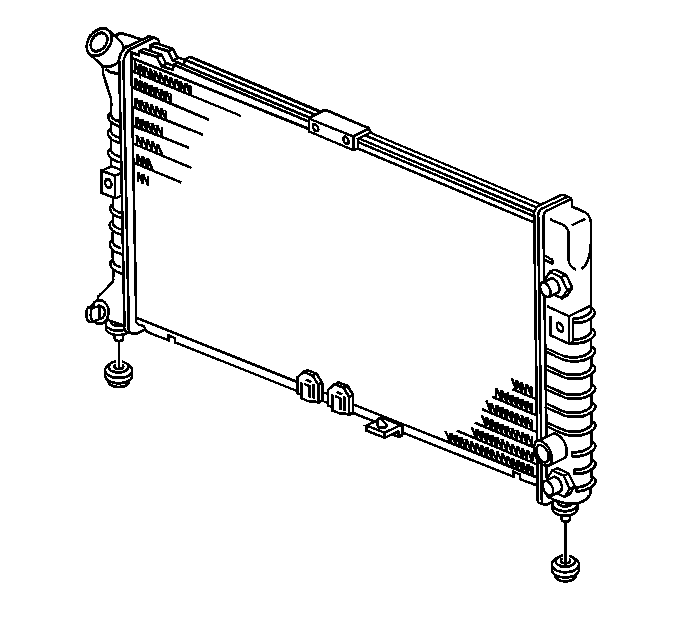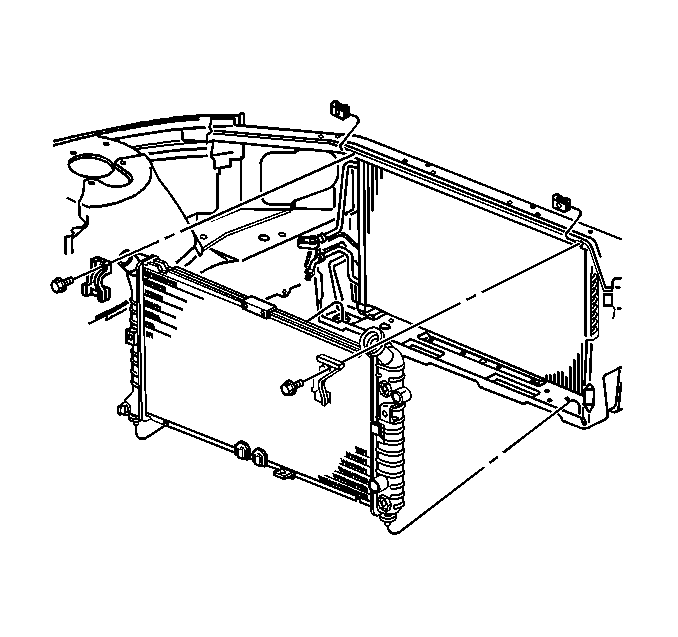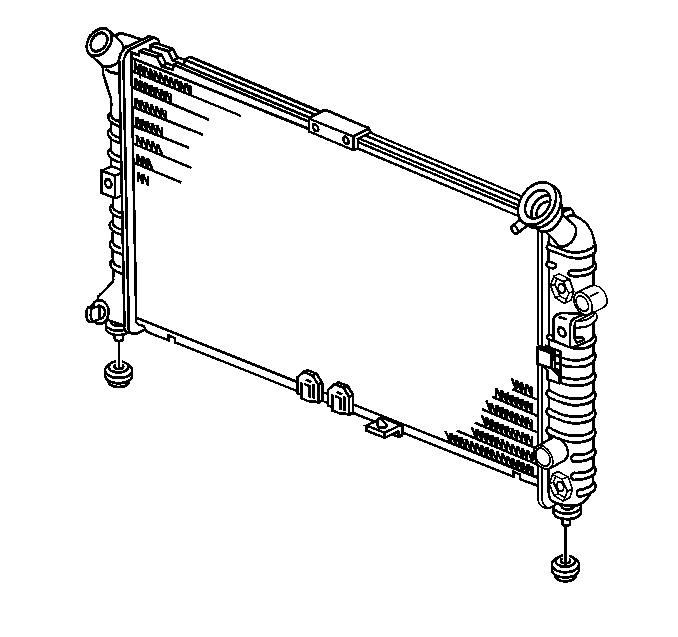Radiator Replacement 3.5L V6 LX5
Removal Procedure
- Remove the battery cable. Refer to Battery Negative Cable Disconnection and Connection in Engine Electrical.
- Drain the engine coolant from the cooling system. Refer to Cooling System Draining and Filling .
- Remove the engine mount strut. Refer to Engine Mount Strut Replacement in Engine Mechanical-3.5L.
- Remove the engine mount strut bracket from the upper radiator support. Refer to Engine Mount Strut Bracket Replacement in Engine Mechanical-3.5L.
- Disconnect the cooling fan wiring harness from the engine harness.
- Disconnect the outlet hose from the radiator. Refer to Radiator Outlet Hose Replacement .
- Disconnect the inlet hose from the radiator. Refer to Radiator Inlet Hose Replacement .
- Remove the cooling fan shroud, motors and fans from the radiator. Refer to Fan Shroud Replacement .
- Disconnect the transmission oil cooler lines from the radiator. Refer to Automatic Transmission Oil Cooler Hose Replacement .
- Remove the radiator mounting bracket.
- Remove the radiator mounting brackets.
- Remove the radiator.
- Remove the radiator mounts.

Caution: Keep hands, tools, and clothing away from the electric engine coolant fans in order to help prevent personal injury. These fans are electric and can turn on whether or not the engine is running. The fans can start automatically with the ignition in the ON position.


Installation Procedure
- Install the radiator mounts.
- Install the radiator.
- Install the radiator mounting brackets.
- Install the radiator bracket bolts.
- Connect the transmission oil cooler lines to the radiator. Refer to Automatic Transmission Oil Cooler Hose Replacement in Automatic Transmission-4T65E.
- Install the cooling fan shroud, motors and fans to the radiator. Refer to Fan Shroud Replacement .
- Connect the inlet hose to the radiator. Refer to Radiator Inlet Hose Replacement .
- Connect the outlet hose to the radiator. Refer to Radiator Outlet Hose Replacement .
- Connect the cooling fan wiring harness to the engine harness.
- Install the engine mount strut. Refer to Engine Mount Strut Replacement in Engine Mechanical -3.5L.
- Fill the cooling system with engine coolant. Refer to Cooling System Draining and Filling .
- Install the battery. Refer to Battery Replacement in Engine Electrical.
- Inspect for leaks.

NOTICE: When adding coolant, it is important that you use GM Goodwrench DEX-COOL® or HAVOLINE® DEX-COOL® coolant. If Coolant other than DEX-COOL® or HAVOLINE® DEX-COOL® is added to the system the engine coolant will require change sooner; at 50 000 km (30,000 mi) or 24 months.

Notice: Use the correct fastener in the correct location. Replacement fasteners must be the correct part number for that application. Fasteners requiring replacement or fasteners requiring the use of thread locking compound or sealant are identified in the service procedure. Do not use paints, lubricants, or corrosion inhibitors on fasteners or fastener joint surfaces unless specified. These coatings affect fastener torque and joint clamping force and may damage the fastener. Use the correct tightening sequence and specifications when installing fasteners in order to avoid damage to parts and systems.
Tighten
Tighten the bolts to 10 N·m (90 lb ft).

Radiator Replacement 3800 V6 L36
Removal Procedure
- Remove the cooling fan assembly. Refer to Engine Cooling Fan Replacement .
- Drain the engine coolant from the cooling system. Refer to Cooling System Draining and Filling .
- Disconnect the coolant recovery hose from the neck of the radiator.
- Remove the coolant level module from the radiator. Refer to Pressure Cap Testing .
- Disconnect the inlet hose from the radiator. Refer to Radiator Inlet Hose Replacement .
- Disconnect the outlet hose from the radiator. Refer to Radiator Outlet Hose Replacement .
- Disconnect the transmission oil cooler lines from the radiator. Refer to Automatic Transmission Oil Cooler Hose Replacement in Automatic Transmission - 4T65E.
- Remove the radiator mounting bracket bolts.
- Remove the radiator mounting brackets
- Remove the radiator.
- Remove the radiator mounts


Installation Procedure
NOTICE: When adding coolant, it is important that you use GM Goodwrench DEX-COOL® or HAVOLINE® DEX-COOL® coolant. If Coolant other than DEX-COOL® or HAVOLINE® DEX-COOL® is added to the system the engine coolant will require change sooner; at 50 000 km (30,000 mi) or 24 months.
- Install the radiator mounts.
- Install the radiator.
- Install the radiator mounting brackets
- Install the radiator bracket bolts.
- Connect the transmission oil cooler lines to the radiator. Refer to Automatic Transmission Oil Cooler Hose Replacement in Automatic Transmission - 4T65E.
- Connect the outlet hose to the radiator. Refer to Radiator Outlet Hose Replacement .
- Connect the inlet hose to the radiator. Refer to Radiator Inlet Hose Replacement .
- Install the coolant level module to the radiator. Refer to Coolant Level Module Replacement .
- Connect the coolant recovery hose to the neck of the radiator.
- Install the cooling fan assembly. Refer to Engine Cooling Fan Replacement
- Install the battery. Refer to Battery Replacement in Engine Electrical.
- Fill the cooling system with coolant. Refer to Cooling System Draining and Filling .
- Inspect for leaks.


Notice: Use the correct fastener in the correct location. Replacement fasteners must be the correct part number for that application. Fasteners requiring replacement or fasteners requiring the use of thread locking compound or sealant are identified in the service procedure. Do not use paints, lubricants, or corrosion inhibitors on fasteners or fastener joint surfaces unless specified. These coatings affect fastener torque and joint clamping force and may damage the fastener. Use the correct tightening sequence and specifications when installing fasteners in order to avoid damage to parts and systems.
Tighten
Tighten the bolts to 24 N·m (18 lb ft).
